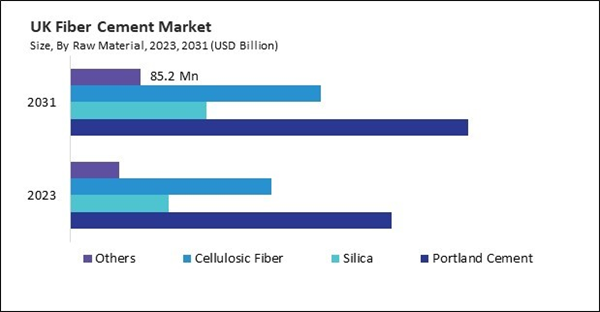Fiber cement finds extensive use in residential construction, offering a durable and versatile solution for various applications. One of its primary residential end uses is siding, where fiber cement panels or boards mimic the appearance of traditional wood siding while providing superior durability and resistance to elements like moisture, pests, and fire. This makes fiber cement siding a popular choice for homeowners looking for a low-maintenance and long-lasting exterior cladding option. Thus, the German residential construction used a total of 1,411.9 kilo tonnes of this cement in 2023.
The Germany market dominated the Europe Fiber Cement Market by Country in 2023, and would continue to be a dominant market till 2031; thereby, achieving a market value of $1,229.6 million by 2031. The UK market is exhibiting a CAGR of 3.2% during (2024 - 2031). Additionally, The France market would experience a CAGR of 2.9% during (2024 - 2031).
As building regulations become stricter regarding fire safety, there is a rising demand for fire-resistant building materials like this cement. This trend is particularly prevalent in regions prone to wildfires or where building codes require enhanced fire protection. Construction materials such as this cement are in high demand due to the rapid urbanization and infrastructure development in emerging economies.
Growing populations and the need for sustainable urban development fuel this trend. Architectural trends, such as modern and minimalist designs, influence the demand for sleek and versatile building materials like this cement. Manufacturers adapt their product offerings to cater to contemporary architectural styles and preferences.
According to Eurostat data, in 2021, a substantial fraction of the EU population resided in primarily urban regions (40.5%) and intermediate regions (38.7%), with the remaining fifth (20.8%) living in predominantly rural regions. Urbanization leads to high-density development in European cities, driving demand for construction materials like this cement. Urbanization increases the vulnerability of cities to climate change and extreme weather events, highlighting the importance of resilient urban infrastructure in Europe. Additionally, the European Commission projects that by 2050, the rate of urbanization in Europe will be approximately 83.7%. Thus, all these factors will uplift the regional market’s expansion in the coming years.
Based on End Use, the market is segmented into Non-Residential and Residential. Based on Raw Material, the market is segmented into Portland Cement, Silica, Cellulosic Fiber, and Others. Based on Construction Type, the market is segmented into Siding, Roofing, Molding & Trim, and Others. Based on countries, the market is segmented into Germany, UK, France, Russia, Spain, Italy, and Rest of Europe.
List of Key Companies Profiled
- Knauf Gips KG (Gebr. Knauf KG)
- Beijing New Building Materials Public Limited Company
- Etex NV
- Swisspearl Group AG
- Saint-Gobain Group
- Toray Industries, Inc.
- CSR Limited
- Nichiha Corporation
- SHERA Public Company Limited
- Beijing Hocreboard Building Materials Co. Ltd.
Market Report Segmentation
By End Use (Volume, Kilo Tonnes, USD Billion, 2020-31)- Non-Residential
- Residential
- Portland Cement
- Silica
- Cellulosic Fiber
- Others
- Siding
- Roofing
- Molding & Trim
- Others
- Germany
- UK
- France
- Russia
- Spain
- Italy
- Rest of Europe
Table of Contents
Companies Mentioned
- Knauf Gips KG (Gebr. Knauf KG)
- Beijing New Building Materials Public Limited Company
- Etex NV
- Swisspearl Group AG
- Saint-Gobain Group
- Toray Industries, Inc.
- CSR Limited
- Nichiha Corporation
- SHERA Public Company Limited
- Beijing Hocreboard Building Materials Co. Ltd.
Methodology

LOADING...









